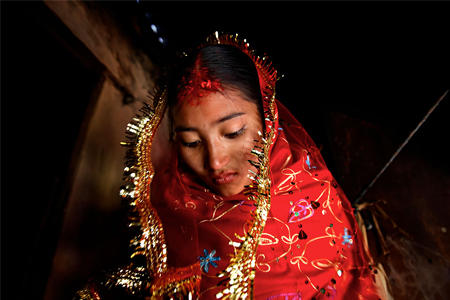Bangladesh has one of the highest rates of child marriage in the world and estimates suggest 74% are married below the age of 18 years.1 From a health perspective, child marriage results in pregnancy and childbirth complications, and other adverse health consequences on young women and their newborns.
At the Girl Summit in July 2014, the Bangladesh Prime Minister pledged to reduce the number of child marriages for girls below 15 years of age; and reduce by one third the number of girls who marry between 15 to 18 years of age, with no child marriages by 2041.2 Since October 2014, there have been renewed debates on the issue of child marriage in Bangladesh with the government drafting a new law, the Child Marriage Restraint Act, 2014, to replace the earlier Child Marriage Restraint Act, 1929. Under consideration is making child marriage a punishable offense for girls married below 16 years of age, as opposed to the existing age of 18 years. The draft law has been criticized for simply following the old law in its concept, without addressing the wide prevalence of child marriage. Increased penalties and stronger implementation of punishments are also viewed as problematic and inadequate. For many lawyers and women rights groups, the draft law falls short as it remains ambiguous and does not outright declare child marriages as illegal. While the law has not yet been passed, it is anticipated that despite the opposition by many concerned groups (i.e. women’s rights groups, civil society members, lawyers, health practitioners), it will be implemented. Many lawyers and rights activists are urging the government to honor its existing obligations under the international treaties such as CEDAW ad CRC and criminalize child marriage itself.3
 Looking at reasons for early marriage among the poor in both rural and urban areas, one is confronted with the myriad complex realities and choices that they face. Poverty, insecurity, violence, lack of choices and limited access to education, jobs and cultural pressures all push young girls to get married early. With one third of a population of 150 million still living in extreme poverty, despite considerable gains in social and economic indicators, poor families decision making regarding child marriage is more often than not influenced by pragmatism that takes into account the social, cultural, economic, and political conditions of their lives.
Looking at reasons for early marriage among the poor in both rural and urban areas, one is confronted with the myriad complex realities and choices that they face. Poverty, insecurity, violence, lack of choices and limited access to education, jobs and cultural pressures all push young girls to get married early. With one third of a population of 150 million still living in extreme poverty, despite considerable gains in social and economic indicators, poor families decision making regarding child marriage is more often than not influenced by pragmatism that takes into account the social, cultural, economic, and political conditions of their lives.
“The boys in the neighborhood harass her and tease my daughter, ‘we want to marry you.’ They try and touch her and trip her.” The mother is planning to go back to the village and put her in school. “If I found a nice man then I would marry her here but over here the men just wander around and eat but they do no work at all.” (Shireen’s mother, 35 years of age, urban slum Dhaka)
“The environment is not good here. If one girl speaks to more than one or two boys then she gets a bad reputation very quickly and then she can become unmarriageable.” (single, Razia, female garment worker, in a Dhaka slum)
“After two months of the marriage I often thought to myself, ‘why did my mother and sister give me in marriage to such a man? I was so young and I had no breasts and I wasn’t even menstruating. But they didn’t want to worry about me and married me off early” (Jharna, 15 years old, rural area)
“I fell in love with him. He was my brother’s friend and he kept visiting us in our locality. One day, he gave me a flower and expressed his love for me. We decided to run away and get married, as his father wanted dowry and my parents didn’t agree. He is good to me.” (16 years, Monsura, female, rural area)
The above narratives are typical of the dilemmas and reality of decision-making for the poorest. Shireen’s mother grapples with gang violence in the slum she resides in, and is anxious about her daughter being harmed. She cannot continue to afford to send her daughter to school and is contemplating sending her back to the village and finding a suitable groom. A single woman, Razia has turned down her father’s offer to marry her off to a cousin in the village because she wants to live in the city and earn an income. Her father does not have the money to pay for dowry for her marriage and she is not clear about his choice. The community gossips about her mobility and unmarried state and her father worries about the family reputation if she engages in premarital sexual behavior. For Jharna, life has been difficult with little choice. She was married off early because of extreme poverty in the household. She was also considered culturally ready for marriage as soon as she started menstruating at 11 years. She remains trapped living a life of certain uncertainties, with her three children and a husband who does not work regularly. Monsura fell in love at 15 and eloped against the wishes of the parents and is hoping to fall pregnant soon with a son, so she can find acceptance with her in-laws.
For the many of the poor, marriage is made within constrained situations. Structural inequalities, along personal, social and emotional factors all come together to shape the decisions and lives of many of these young women. To push the government to enact a law that declares child marriage as illegal can be argued as only one step in the right direction, but this cannot be implemented or viewed in isolation given the stark reality of poor unmarried young girls, who remain more vulnerable to violence, lack access to stable employment, education, and increased demands in dowry (i.e. illegal but a common practice where demands are made of the bride’s family to pay cash/in kind). Given this reality, it is not clear what the government’s motivation is for drafting a law that sets the age of marriage for girls at 16 years. Furthermore, penalizing or instituting draconian punishments are simply inadequate given the vulnerabilities of the poor, and will only drive many of these cases underground. The real work lies in acknowledging the structural poverty and entrenched inequalities that shape many of the poor’s lives and findings solutions that incorporate a more comprehensive holistic approach to the problem of child marriage.
Sabina Faiz Rashid is Professor and Dean at the James P. Grant School of Public Health, BRAC University. Her areas of interest and expertise are ethnographic research, academic teaching and advocacy in the areas of Gender, Sexual and Reproductive Health and Rights, Urban poor populations in slum settlements, and Reform and Innovations in Public Health Curriculum for Health Professionals of the 21st Century
___________
1 UNICEF. Ending Child Marriage: Progress and Reports. Division of Policy and Research. UNICEF, New York, 2014 (referenced in SAFE Project – BLAST, unpublished report – FAQs on Child marriage, Dhaka, Bangladesh)
2 Bangladesh Prime Minister Sheikh Hasina attends the ‘Girl Summit 2014’ in London on July 22, 2014. 2014 Reuters.
3 Knowing your rights: FAQs on Child Marriage and the law in Bangladesh. SAFE Project – BLAST, unpublished report , Dhaka, Bangladesh (2014).
